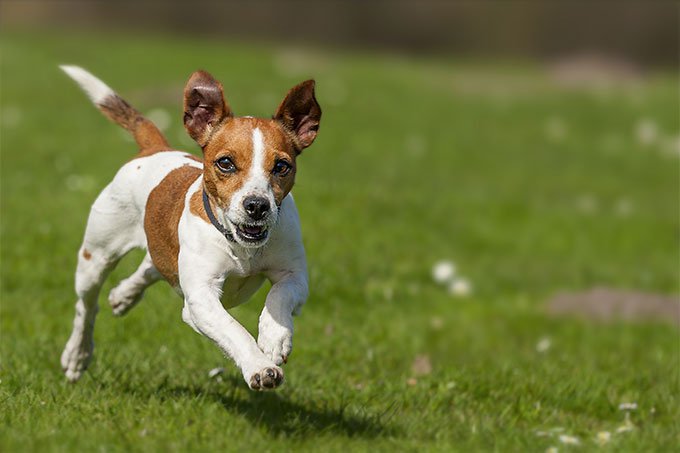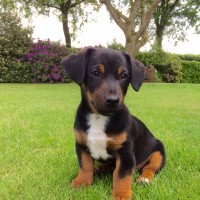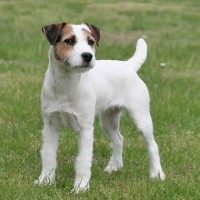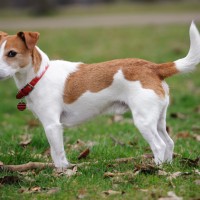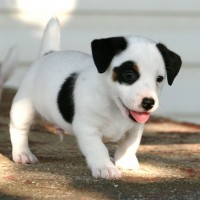Breed information
Group:
Terrier
Life span: 13-16 years
Height male: 20-38 cm/ 8-15 inches
Height female: 20-38 cm/ 8-15 inches
Weight male: 5-8 kg/ 11-18 pounds
Weight female: 5-8 kg/ 11-18 pounds
Character: Alert, Cheerful, Courageous, Energetic, Independent
History
Sporting parson
The small white fox-working terriers we know today were first bred by the Reverend John Russell, a parson and hunting enthusiast born in 1795, and they can trace their origin to the now extinct English white terrier. An important attribute in this dog was a tempered aggressiveness that would provide the necessary drive to pursue and bolt the fox, without resulting in physical harm to the quarry and effectively ending the chase, which was considered unsporting. Russell was said to have prided himself that his terriers never tasted blood. This line of terriers developed by John Russell was well respected for those qualities, and his dogs were often taken on by hunt enthusiasts. It is unlikely, however, that any dogs alive today can be proved to be descendants from Trump, as Russell was forced to sell all his dogs on more than one occasion because of financial difficulty, and had only four aged (and non-breeding) terriers left when he died in 1883.
The Fox terrier and Jack Russell terrier type dogs of today are all descended from dogs of that period, although documented pedigrees earlier than 1862 have not been found, although several records remain of documented breeding by John Russell between the 1860s and 1880s. The Fox Terrier Club was formed in 1875 with Russell as one of the founder members; its breed standard was aspiration, and not a description of how the breed appeared then. By the start of the 20th century, the Fox terrier had altered more towards the modern breed, but in some parts of the country the old style of John Russell's terriers remained, and it is from those dogs that the modern Jack Russell type has descended. Many breeds can claim heritage to the early Fox terrier of this period, including the Brazilian terrier, Japanese terrier, Miniature Fox terrier, Ratonero Bodeguero Andaluz, Rat terrier, and Tenterfield terrier.
After John Russell
Following Russell's death, the only people who made serious efforts to continue those strains were two men, one in Chislehurst with the surname of East, and another in Cornwall named Archer. East, at one point, had several couples, all of which were descended from one of Russell's dogs. The type aimed for were not as big as the show Fox terrier and were usually less than 15 pounds (6.8 kg).
Arthur Blake Heinemann created the first breed standard and, in 1894, he founded the Devon and Somerset Badger Club, the aims of which were to promote badger digging rather than fox hunting, and the breeding of terriers suitable for this purpose. Terriers were acquired from Nicholas Snow of Oare, and they were likely descended from Russell's original dogs, as Russell would probably have hunted at some point with Snow's hunting club and is likely to have provided at least some of their original terriers. By the turn of the 20th century, Russell's name had become associated with this breed of dog.
The club was later renamed the Parson Jack Russell Terrier Club. Badger digging required a different type of dog than fox hunting, and it is likely that Bull terrier stock was introduced to strengthen the breed, which may have caused the creation of a shorter legged variety of Jack Russell terrier that started to appear around this period. At the same time that a split was appearing between show and working Fox terriers, a further split was occurring between two different types of white terrier, both carrying Jack Russell's name. Heinemann was invited to judge classes for working terriers at Crufts with an aim to bring working terriers back into the show ring and influence those that disregard working qualities in dogs. These classes were continued for several years by various judges, but Charles Cruft dropped the attempt as the classes were never heavily competed. Following Heinemann's death in 1930, the kennel and leadership of the club passed to Annie Harris, but the club itself folded shortly before World War II.
Post World War II
The Jack Russell Terrier Club of America was formed in 1976 by Ailsa Crawford, one of the first Jack Russell terrier breeders in the United States. Size ranges for dogs were kept broad, with the ability of working dogs awarded higher than those in conformation shows. An open registry was maintained, with restricted line breeding. Registration for the club is made at adulthood for Jack Russells, rather than at birth, to ensure the breed's qualities remain, given the open registry.
Several breed clubs appeared in the United Kingdom during the 1970s to promote the breed, including the Jack Russell Club of Great Britain (JRTCGB) and the South East Jack Russell Terrier Club (SEJRTC). Jack was dropped from the official name in 1999, and the recognised name of the breed became the Parson Russell terrier. In the late 1990s, the American Kennel Club explored the possibility of recognising the Jack Russell terrier.
The Australian National Kennel Council (ANKC) and the New Zealand Kennel Club (NZCK) are some of national kennel associations that register both the Jack Russell terrier and the Parson Russell terrier; however, the size requirements for the Jack Russell terrier under both those standards would classify a dog as a Russell terrier in the United States. In 2009, there were 1073 Jack Russells registered with the ANKC, compared to 18 for the Parson Russell terrier. Other modern breeds are often mistaken for modern Jack Russell terriers, including their cousin the Parson Russell terrier, the Tenterfield terrier, and the Rat Terrier. Several other modern breeds exist that descended from the early Fox Terrier breed, including the Brazilian Terrier, Japanese Terrier, Miniature Fox Terrier, Ratonero Bodeguero Andaluz, Rat Terrier, and Tenterfield Terrier.
Description
The Russell Terrier is a strong, active, lithe, predominately white bodied working Terrier of character with a flexible body of moderate length and rectangular profile. The overall dog must present a balanced image with no one part exaggerated over another. The Russell Terrier is full of life, and moves with confidence that matches his keen expression. Coat may be smooth, broken or rough and may have tan and/or black markings with no preference for coat type or markings. Tail docking is optional.
Health
The breed has a reputation for being healthy with a long lifespan. Breeders have protected the gene pool, and direct in-line breeding has been prevented. Jack Russells can live from 13 to 16 years given proper care. However, certain lines have been noted for having specific health concerns and, therefore, could occur in any line or generation because of recessive genes. These issues can include hereditary cataracts, ectopia lentis, congenital deafness, patellar luxation, ataxia, myasthenia gravis, Legg–Calvé–Perthes syndrome, and von Willebrand disease. Being a hunt-driven dog, the Jack Russell will usually pursue most creatures that it encounters. This includes the skunk, and the breed is prone to skunk toxic shock syndrome. The chemical in the skunk spray is absorbed by the dog and causes the red blood cells to undergo haemolysis, which can occasionally lead to fatal anaemia and kidney failure. If sprayed underground, it can also cause chemical burning of the cornea. Treatments are available to flush the toxin out of the dog's system.
Eye disorders
Lens luxation, also known as ectopia lentis is the most common hereditary disorder in Jack Russell terriers. Even so, this condition is not a common occurrence in the breed. Most frequently appearing in dogs between the ages of 3 and 8 years old, it is where the lens in one or both eyes becomes displaced. There are two types, posterior luxation (where the lens slips to the back of the eye) and anterior luxation (where the lens slips forward). Posterior luxation is the less severe of the two types, as the eye can appear normal although the dog's eyesight will be affected. In anterior luxation, the lens can slip forward and rub against the cornea, damaging it. Anterior luxation also has a high probability of causing glaucoma which can lead to partial or complete blindness. Treatment is available and may include both medical and surgical options. Secondary lens luxation is caused by trauma to the eye and is not hereditary. The condition appears in a number of terrier breeds as well as the Border collie, Brittany and Cardigan Welsh corgi. Cataracts can affect any breed of dog and is the same condition as seen in humans. Here the lens of the eye hardens and is characterised by cloudiness in the eye. Cataracts will blur the dog's vision and can lead to permanent blindness if left untreated. While considered mainly a hereditary disease, it can also be caused by diabetes, old age, radiation, eye injury or exposure to high temperatures.
Musculoskeletal conditions
Patellar luxation, also known as luxating patella, is a hereditary disorder affecting the knees. It is where the kneecap slips off the groove on which it normally sits. The effects can be temporary with the dog running while holding its hind leg in the air before running on it again once the kneecap slipped back into place as if nothing has happened. Dogs can have a problem with both rear knees, and complications can include arthritis or torn knee ligaments. Severe cases can require surgery. Some are prone to dislocation of the kneecaps, inherited eye diseases, deafness and Legg Perthes—a disease of the hip joints of small dog breeds. Prone to mast cell tumors. Legg–Calvé–Perthes syndrome, also called Avascular Necrosis of the Femoral Head, is where the ball section of the femur in the hip joint deteriorates following interruption of the blood flow and is the same condition as in humans. In dogs, this causes lameness of the hind-legs, the thigh muscles to atrophy and pain in the joint. It usually occurs between 6–12 months of age and has been documented in a variety of other terrier breeds including the Border terrier, Lakeland terrier, and Wheaten terrier.
Personality
Jack Russell Terriers are the biggest dogs you'll ever meet in such a tiny package. They can run all day and keep coming back for more. They are sharply intelligent and absolutely nothing gets past them. There is no fooling a Jack Russell. They are spirited terriers, fearless and sassy with minds of their own and aren't above causing mischief to get a laugh. They are highly trainable and are famous for their high-jumping antics. When raised alongside children, Jack Russells make fine family dogs. They are exceptional athletes who excel in the competitive arena.
Activity Requirements
Their size may make them appealing to apartment dwellers, but Jack Russells are not apartment dogs. Think of them as large dogs trapped in small bodies. They need lots of wide open space to run and can feel cooped up inside a small apartment which will almost always lead to destructive behavior. Fenced in yards are a must, as Jack Russells will take off like a shot after cats, squirrels, rabbits, bikes, and even cars. They should always be supervised when outdoors because these little guys love to dig and not only will the make quick work of a flower bed, but they will dig under fences to get out and seek new adventure.
Daily activities should include both walking and time to run in the yard. Jack Russells love, love, love to chase balls. They love it so much, in fact, that many owners believe their dogs are obsessed with playing ball. They will retrieve the ball as often as you are willing to throw it, and when you're done, he'll still want more. Jack Russell Terriers are highly intelligent dogs and need as much mental stimulation as they do physical activity. These dogs excel in agility activities and there are entire competitions set up around Jack Russell Terriers that include sprinting, flyball, obstacle course and retrieving. Enrolling your Jack Russell in these types of activities ensures he's getting his daily physical and mental stimulation. “Earth dog” activities, where dogs are allowed to dig in search of rodents is also an excellent outlet for Jack Russells, as it satisfies their need to dig as well as their need to hunt. These activities are conducted with safety in mind, and the rodents are kept in safe enclosures, so that the dogs can't actually get to them.
Trainability
Jack Russells are highly trainable dogs and soak up new tasks like a sponge. They are terriers and can exhibit stubbornness if they don't like the attitude of the person training them. Positive reinforcement and mixing up the daily training routine will keep your Jack Russell engaged and interested. Discipline and harsh tones will cause this dog to become defensive which may lead to snapping or biting. Once basic obedience is mastered, Jack Russells should move on to advanced obedience, trick training and agility work. They thrive on new activity and will be at the top of their class in just about every activity they participate in.
Best Training Equipment Trainers Recommend
Behavioral Traits
Jack Russells are terriers, and they exhibit many classic terrier traits including excessive barking, willfulness, rudeness to strangers, dog aggression, possessiveness and jealousy. Proper training and socialization from an early age can ensure an even-tempered dog. Jacks should never be trusted off leash. They will take off like a shot after small animals and it is next to impossible to call them off. Digging is a common complaint among Jack Russell owners. Turn your back on these guys for one second, and they can be halfway to the center of the earth. Keeping an eye on your dog at all times is important to keep your landscaping in tact and to ensure your Jack doesn't escape under the fence.
Shedding
No matter the coat type, smooth or broken, weekly brushing will keep the hair neat and clean and will prevent flyaways from landing on furniture or carpet. Only bathe a Jack as needed, which, with regular brushing, shouldn't be very often. The broken coated Jack Russell requires stripping twice a year to maintain the proper coat texture. Check the ears on a regular basis for signs of wax buildup, irritation or infection. Clean the ears with a cotton ball and a veterinarian-approved cleanser; never use a cotton swab in a dog's ear canal. Teeth should be brushed on a weekly basis to prevent tartar buildup, promote gum health and keep bad breath at bay. Trim nails monthly if the dog does not wear the toenails down naturally outdoors.
